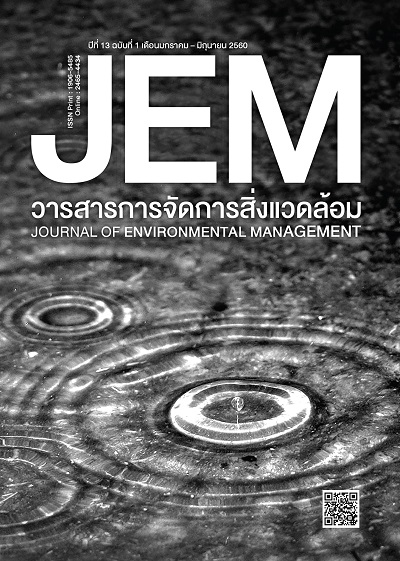การประเมินการปนเปื้อนของโลหะหนักในฝุ่นที่ผนังของบ้านเรือนในเขตพื้นที่เกษตรกรรม จังหวัดสุโขทัย Contamination assessment of heavy metals in dust deposited on residential building walls in agricultural areas of Sukhothai
DOI:
https://doi.org/10.14456/jem.2017.2บทคัดย่อ
งานวิจัยนี้ทำการวิเคราะห์โลหะหนัก ได้แก่ เหล็ก สังกะสี ทองแดง ตะกั่ว และแคดเมียม ในฝุ่นที่ตกลงบ้านเรือนที่อยู่ในชุมชนเกษตรกรรม จังหวัดสุโขทัย โดยเก็บตัวอย่างฝุ่นด้วยวิธีการ ปัดด้วยแปรงโพลิเอทิลีน บริเวณผนังภายในและ ภายนอกของบ้าน จำนวน 16 หลังคาเรือน สุ่มเก็บ ตัวอย่างเดือนละ 2 ครั้ง เป็นระยะเวลา 3 เดือน แล้ว นำมาวิเคราะห์โลหะหนักด้วย Atomic Absorption Spectroscopy (AAS) ผลการศึกษาพบว่าความเข้มข้น ของโลหะหนักในฝุ่นภายในและภายนอกบ้านไม่มีความแตกต่างกัน ยกเว้นเหล็กซึ่งพบว่า เหล็กมีค่าเฉลี่ยสูงสุดทั้งจากฝุ่นภายในและภายนอกบ้าน มีค่าเท่ากับ 35,091±7,159 และ 37,064±5,955 มิลลิกรัมต่อกิโลกรัม ตามลำดับ ความเข้มข้นของโลหะหนักของฝุ่นภายในและภายนอกบ้านเรียงตามที่ตรวจพบได้ดังนี้ เหล็ก >สังกะสี > ตะกั่ว > ทองแดง > แคดเมียม ตามลำดับ ส่วนปัจจัยการปนเปื้อนของโลหะหนักในฝุ่น (Enrichment Factor: EF) พบว่า แคดเมียม ตะกั่ว และสังกะสี มีค่า EF สูง ซึ่งแสดงให้เห็นว่าการปนเปื้อนของโลหะหนักมาจากกิจกรรมที่เกี่ยวข้องกับมนุษย์ ดังนั้นกระบวนการสร้างความตระหนักด้านมลพิษจึงมีความจำเป็นเพื่อให้เกิดการ ปรับเปลี่ยนทัศนคติและพฤติกรรม และเพื่อลดความเสี่ยงต่อสุขภาพอนามัยและสิ่งแวดล้อม
This study determined the concentration of heavy metals (Fe, Zn, Cu, Pb and Cd) in the settled surface dust of residential buildings near the agricultural areas of Sukhothai province in Thailand. Samples of dust were collected from interior and exterior walls by using a polyethylene brush. Random samples from 16 houses were collected twice a month for three months. The heavy metal compositions were analyzed using Atomic Absorption Spectroscopy (AAS). The results showed that the mean concentrations of heavy metals of indoor and outdoor house dust were not significantly different, with the exception of Fe. Fe was found to be the highest in both indoor and outdoor house dust, with 35,091±7,159 and 37,064±5,955 mg/kg, respectively. The heavy metal concentrations of indoor and outdoor houses followed the following trend: Fe > Zn > Pb > Cu > Cd. Enrichment Factor (EF) analysis showed that Cd, Pb, and Zn had high EF values, indicating that heavy metal contaminations may be contributed from anthropogenic activities. Thus, an awareness-raising programme is important in order to change people’s attitude and behaviour and to reduce risks to human health and the environment.
References
Abdul Wahab, N. A., Darus, F. M., Isa, N., Sumari, S. M. & Hanafi, N. F. M. (2012). Heavy metal concentration of settled surface dust in residential building. The Malaysian Journal of Analytical Sciences, 16(1), 18 – 23.
Abechi, E. S., Okunola, O. J., Zubairu, S. M. J., Usman, A. A. & Apene, E. (2010). Evaluation of heavy metals in roadside soils of major streets in Josmetropolis, Nigeria. Journal of Environmental Chemistry and Ecotoxicology, 2(6), 98 – 102.
Al-Momani, I. F. (2007). Trace elements in street and household dusts in Amman, Jordan. Soil & Sediment Contamination: International Journal, 16(5), 485 – 496.
Bruce, N., Perez-Padilla, R. & Albalak, R. (2000). Indoor air pollution in developing countries: a major environmental and public health challenge. Bulletin of the world health organization, 78(9), 1078 – 1092.
Choo-In, S. (2013). Air pollution [In Thai]. Bangkok: Chulalongkorn University Press.
Darus, F. M., Nasir, R. A., Sumari, S. M., Ismai, Z. S. & Omar, N. A. (2012). Heavy metal composition of indoor dust in nursery schools building. Procedia – Social and Behavioral Sciences, 38, 169 – 175.
Duong, T. T. T., & Lee, B. K. (2011). Determining contamination level of heavy metals in road dust from busy traffic areas with different characteristics. Journal of Environmental Management, 92(3), 554 – 562.
Gietl, J. K., Lawrence, R., Thorpe, A. J. & Harrison, R. M. (2010). Identification of brake wear particles and derivation of a quantitative tracer for brake dust at a major road. Atmospheric Environment, 44(2), 141 – 146.
Karuchit, S & Hirunkam, T. (2015). Multivariate analysis of heavy metal concentrations in soil, roof dust, and dust fall in Nakhon Ratchasima, Thailand. Suranaree Journal of Science and Technology, 22(2), 173 – 182.
Krejcie, R. V. & Morgan, D. W. (1970). Determining sample size for research activities. Educational and Psychological Measurement, 30(3), 607 – 610.
Land Development Department. (2015). Sukhothai Land Use Map [In Thai]. Division of Land Use Policy and Planning, Land development Department.
Latif, M., Yong, S., Saad, A., Mohamad, N., Baharudin, N., Mokhtar, M. & Tahir, N. (2014). Composition of heavy metals in indoor dust and their possible exposure: a case study of preschool children in Malaysia. Air Quality, Atmosphere & Health, 7(2), 181 – 193.
Lawson, D. R. & Winchester, J. W. (1979). A Standard Crustal Aerosol as Reference for Elemental Enrichment Factors. Atmospheric Environment, 13(7), 925 – 930.
Lemieux, P. M., Lutes, C. C. & Santoianni, D. A. (2004). Emission of Organic Air Toxics from Open Burning: A Comprehensive Review. Progress in Energy and Combustion Science. 30(1), 1 – 32.
Pollution Control Department. (2013). The 2013 Report on Pollution Situation [In Thai]. Ministry of Natural Resources and Environment, Thailand.
Pope, C. A., Bates, D. A. & Raizenne, M. E. (1995). Health Effects of Particulate Air Pollution: Time for Reassessment? Environmental Health Perspective, 103(5), 472 – 479.
Srithawirat, T. & Latif, M. T. (2015). Concentration of selected heavy metals in the surface dust of residential buildings in Phitsanulok, Thailand. Environmental and Earth Science, 74(3), 2701 – 2706.
Sultan, K. & Shazili, N. A. (2009). Distribution and geochemical baselines of major, minor and trace elements in tropical top soils of the Terengganu River basin, Malaysia. Journal of Geochemical Exploration, 103(2–3), 57 – 68.
Tahir, N. M., Poh, S. C. & Jaafar, M. (2007). Determination of heavy metal contents in soils and indoor dusts from nurseries in Dungun, Terengganu. The Malaysia Journal of Analytical Sciences, 11(1), 280 – 286.
Taylor, S. R., & McLennan, S. M. (1995).The Geochemical Evolution of the Continental Crust. Reviews of Geophysics, 33(2), 241 – 265.
Thorpe, A., & Harrison, R. M. (2008). Sources and properties of non-exhaust particulatematter from road traffic: a review. Science of the Total Environment, 400(1–3), 270 – 282.
Vichit-Vadakan, N. & Vajanapoom, N. (2011). Health Impact from Air Pollution in Thailand: Current and Future Challenges. Environmental Health Perspectives, 119(5), A197 – A198.
Yongming, H., Peixuan, D., Junji, C. & Posmentier, E. S. (2006). Multivariate analysis of heavy metal contamination in urban dusts of Xi’an, Central China. Science of the Total Environment, 355(1–3), 176 – 186.


